If I Climb to the Heavens You are There.

It’s not that I’m afraid of heights. Not exactly. I like rollercoasters and the occasional high dive. But I’m not the kind of person who walks as close to the edge of a cliff to prove to everyone that I am not afraid. I have a healthy respect for the fact that the distance between me and the ground acts like a multiplier for my stupidity.
For this reason, working on roofs is not my favorite thing in the world. When I’m on the roof, I have a heightened awareness that an error that wouldn’t matter at all on solid ground could have long-term consequences. Being on high alert like that for several hours is pretty exhausting.
Of course, the next major task was putting a roof on the house. I’d ordered the trusses a few weeks earlier and they got delivered as I finished up the interior walls and double top plates. If you’ve never seen a truss, it’s a big triangular structure the shape of a roof that is manufactured by companies that specialize in trusses. When you’re building a roof, you space them two feet apart and tie them all together with plywood and 2x4s to make the top of a house.
Bringing in (Nail)Gunslingers.
Throughout this process, I’ve tried to carefully weigh which tasks I can do myself and which ones require specialized help. Running the electrical and finishing the concrete are two examples of jobs beyond my abilities. Putting up trusses is another one. So I called my friend Nick Wingate.
Nick is one of the coolest, toughest guys I know. A former marine, he now runs the construction side of things for his father-in-law’s construction company. He can build anything. He’s also a devout Catholic with 12 kids and another one on the way. Nick told me that he could bring a couple of his guys and help me put up the trusses and tie them into the existing house.
Time for Another Work Party.
If you’ve read any of the other posts in this saga, you’ve heard the phrase “work party” more than once. There’s something awesome about getting a bunch of men together and building something. As a team, we’re able to accomplish things I could never do alone. I feel positively Amish.
The Saturday after I finished the interior walls, I summoned my crew. There were about 10 of us there, including Nick and his guys. The first thing we had to do was make sure the walls were straight and well braced. Nick and his guys climbed on top of the walls and used a string to check where the walls were out of alignment. Then we pushed and pulled and used 2x4s staked into the ground to keep them in the right place.
Well-braced walls are extremely important when you’re putting up a roof. The story of Jericho illustrates the reason perfectly. The last thing you want when you’re installing a roof is for the walls to come tumbling down.
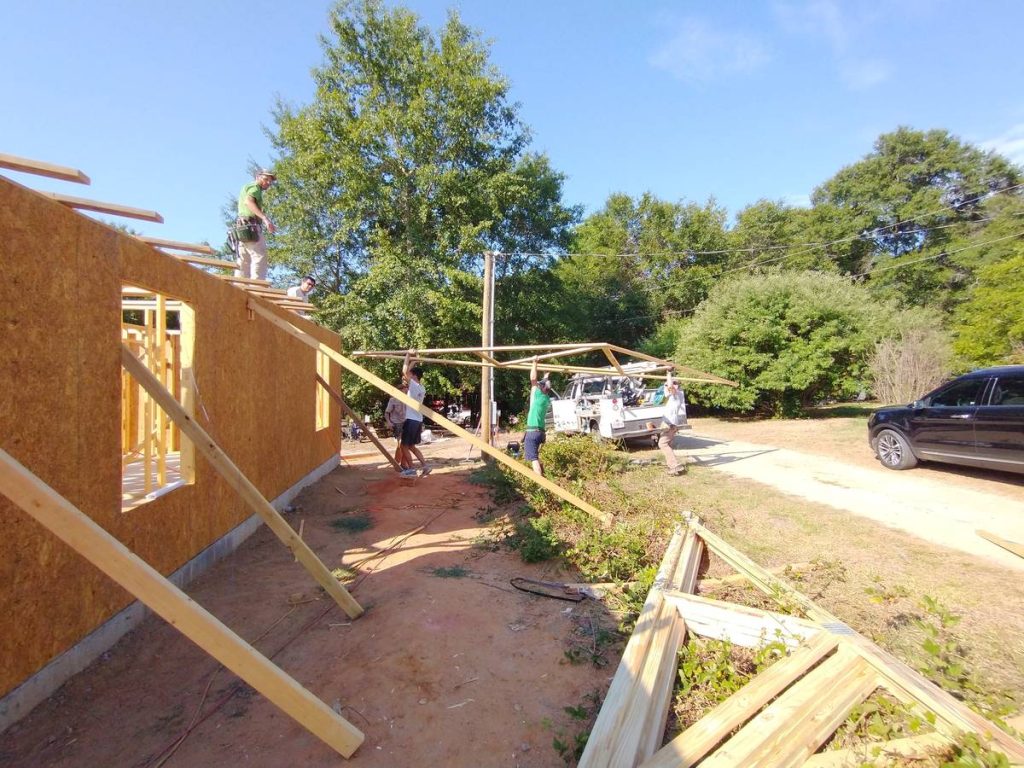
Next, we lifted the trusses up onto the house. I was on the ground with several other guys, and we lifted the trusses to the guys up on top of the walls. We stacked them up like dominoes toppled over so we could then stand them up one after another. This also created a nice lattice of 2x4s that the guys could walk around up in the air.

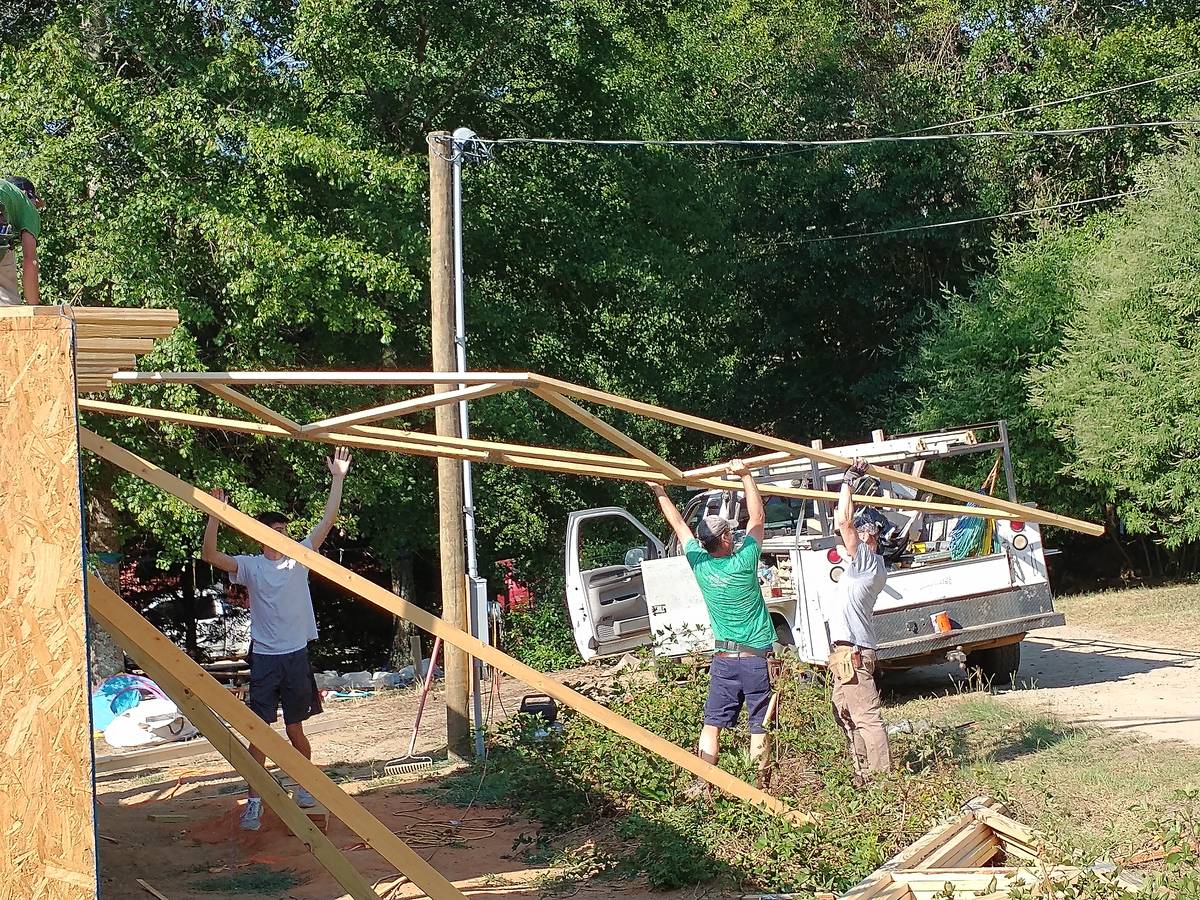
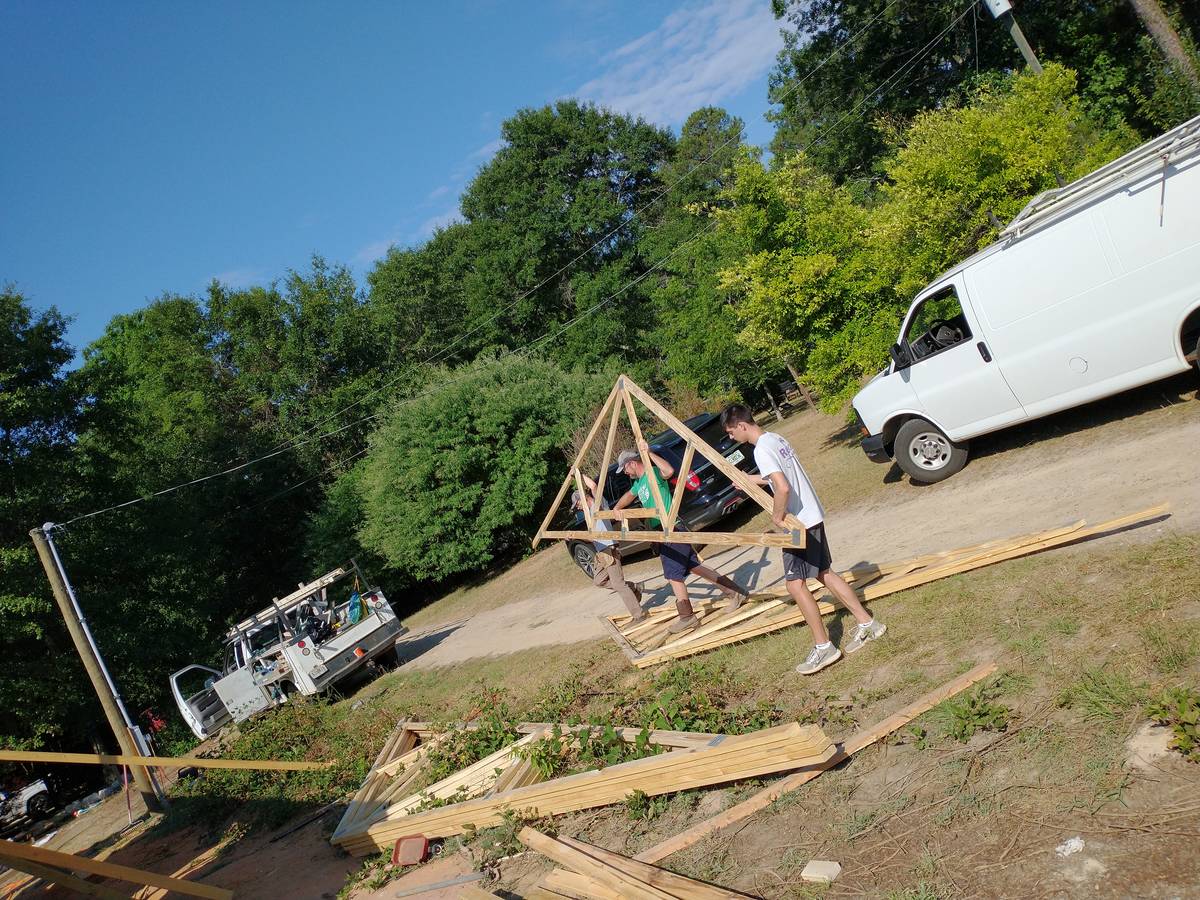
Nick and his guys started to stand the trusses up, using more 2x4s they called lacing to tie them together. The speed with which they were able to do this amazed me. They made sure that the first truss on the back of the house was very well braced so that it could support the other trusses.

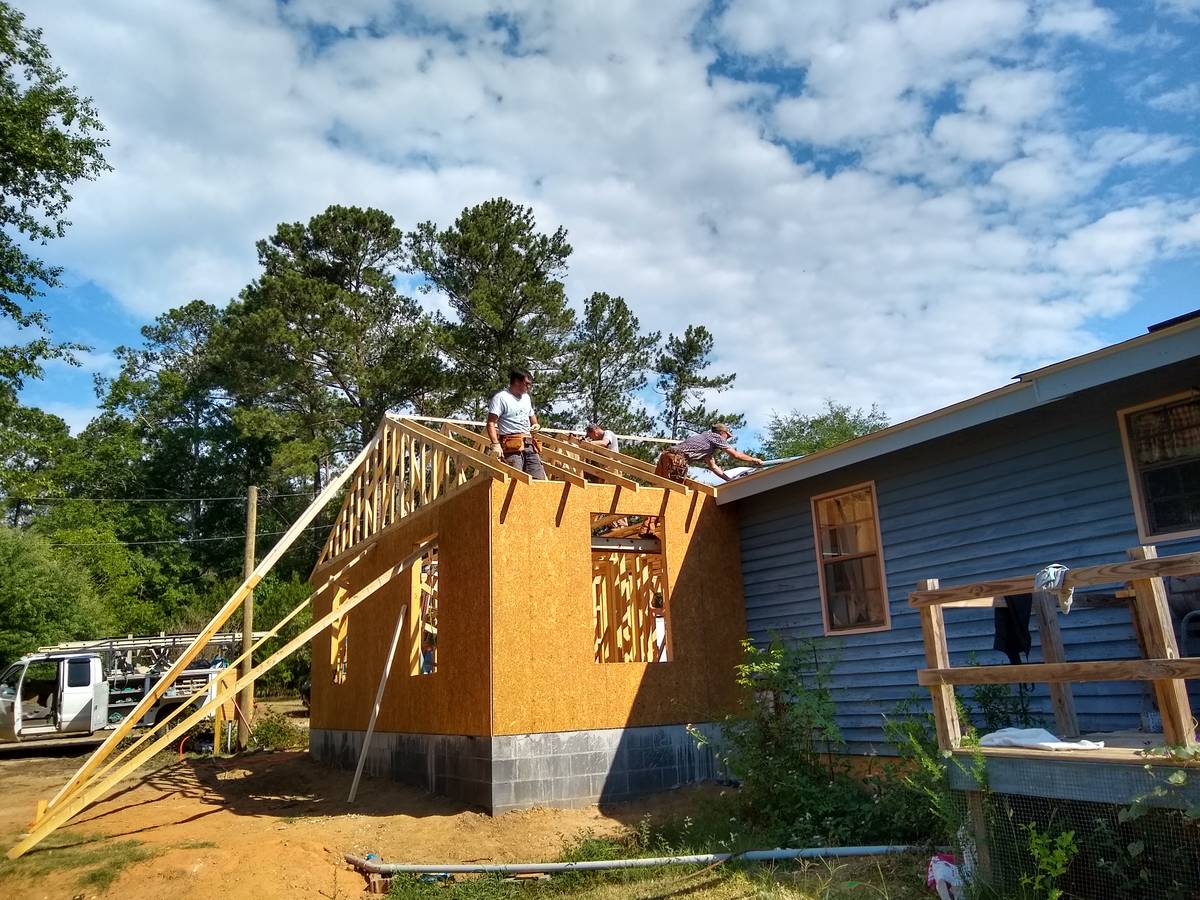
While they continued towards the front of the house, I helped to nail the trusses in with hurricane clips. These little metal braces make sure that the trusses are very well connected to the walls. Very helpful in a high wind situation. Not that that happens much in my part of Georgia.
My next task was helping David Johnson, one of Nick’s guys, hang the 2x6s on the ends of the trusses that would eventually turn into the soffit and fascia.
David is a total hoss. I would hold one end of the 2×6, and he would position it in the right place. After popping three nails through the 2×6 into two trusses, he just stepped out onto the 2×6 so he could get a better angle for nailing it to the next truss. It made sense. Stepping out into thin air obviously the fastest way to do it. It was just totally crazy.
Once the trusses were up, we split into two crews. One group of us started putting on the decking, which is the plywood that supports the shingles. Nick led the other group, which started working on connecting the old house to the new addition.
While helping with the decking, I realized that I’m incapable of cutting a straight line with a circular saw. It was a little embarrassing. None of the guys mentioned it, but the edges of the plywood that I cut looked like a straight line drawn by my four-year-old daughter with a crayon. In a moving car. I stepped back and let more competent people cut. The best thing that I could do at this point was help lift plywood up to the guys on the trusses.
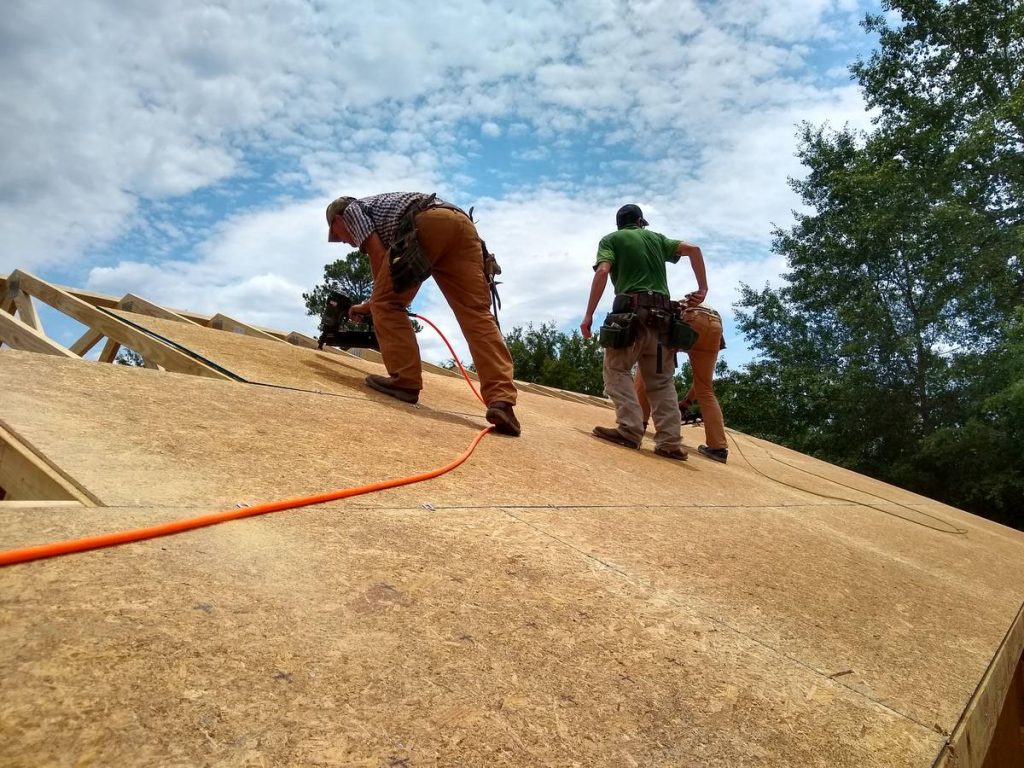
Nick took a Sawzall and chopped off about a foot of my old roof. He needed to make room to put a 2×4 so he could place new rafters. I don’t understand how he did it, but he just shouted numbers to his guys on the ground, who cut and tossed angled pieces of 2×4 and 2×6 up to him. I helped Jordan, his other carpenter, place support rafters underneath the decking where they were tying in the roof. These provide the strength to hold the weight of the new roof.
With the new rafters in place, Nick started measuring and calling out measurements for fitted sheets of plywood decking to cover it all up. The other side was completely decked by this point, so they started to cover it with something called Elephant Skin, which is a waterproof barrier that goes under the shingles.
We realized at about this point that the walkboard that Nick had used to start building the connecting rafters was actually built into the house. A walkboard is a piece of braced aluminum about 20 feet long that you put in between studs as temporary scaffolding. They had slid it into place over the walls before the trusses went up. With the trusses in place, it was stuck inside the house.
I took a Sawzall and cut the nails on about three studs on interior walls. That gave me just enough wiggle room to weasel the walkboard out a window.
How do you skin a house?
My crew had slowly dwindled throughout the day as the big jobs were completed. After Nick Wingate finished putting the decking on the last piece of roof, he showed me how to put elephant skin over the valley where the old roofline met the new roofline. Then he and the rest of his guys said goodbye.
My last helper was Michael Almeter, who’s my friend Nick Almeter’s second son. I was his confirmation sponsor. He’s going to be a senior in High School next year, and he has his dad’s work ethic. Nick Wingate left me a special pneumatic staple gun that uses round plastic caps to get a better hold of things like Elephant Skin. So we’d roll out the skin, Michael would hold it in place, and I’d put a bunch of staples to hold it down.
To make the valleys watertight, you overlap the elephant skin, first along one angle of the roof, then from the other side of the roof. I think they call it weaving it together. The big thing that you want to avoid is putting any staples right in the middle of the valley, because that can cause disastrous leaks. We climbed higher and higher on the roof until we cleared the valley. Only two more strips of Elephant skin and we’d be done.
Then the stapler quit. I don’t know what happened. Sometimes these things jam, and people who use the tools a lot will know how to fix them. I had no idea. But I did have a couple hammers and a box of button cap nails. I’d bought them just in case.
Michael was such a trooper. He grabbed a hammer and handful of nails and got to work alongside me. At around 6, his dad, Nick, showed up to get him for dinner. By this point, we were halfway done nailing the last strip. Nick saw that we were almost done and picked up hammer. We banged it out in no time.
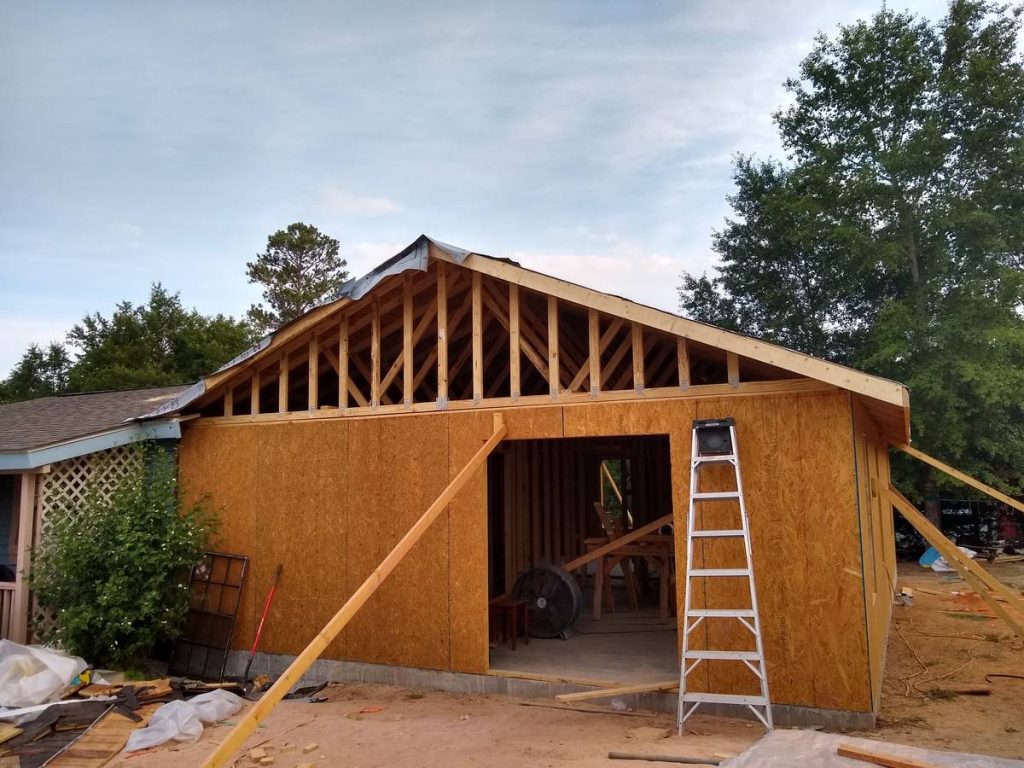
It had been a long day, but we finished what we’d set out to do. The roof was done.
Everyone’s generosity during this process has blown me away. The following people have helped to make this project a reality. I couldn’t have gotten this far without them: Larry Harris, Mary Krupa, David Jude Krupa, Joseph Krupa, Catherine Krupa, Jonathan Krupa, Jerry Germann, Joe Almeter, Nick Almeter, Lawrence Almeter, Michael Almeter (his son), Michael Almeter (his cousin), Tag Bussey, Leo Suer, Ben Suer, Matthew Suer, Pat Molitor, Tom Molitor, Hannes Molitor, Pat Muller, Nick Wingate, David Johnson, Jordan Goodman, David McGee, Glen and the guys at Maner, David Germann, Tom Krupa, Joseph Krupa, Joseph Muller, Philip Hatfield, Miguel Melendez, Maddox, Jared Miller, Fr. Jacob Almeter, Anthony Almeter, Bob Visintainer, Ross Ott, Noah Ott, Max Molitor, Peter Molitor, Mike Hayes, Gabriel Hays, Kolbe Almeter, Luke Almeter, Charlie Almeter, Eric Sterett, and Gabriel Hayes.
If you don’t have time or tools to donate, but would like to help make the House of Krupa a reality, a financial gift would be a great blessing. This is kind of like a do-it-yourself GoFundMe. DIY is my style.
If you want to read more of my adventures building the House of Krupa, check out the archive!
Jesus snatched me out of the darkness and saved me from complete madness. If you want to hear more of that story, check out Demoniac, now available on Amazon.

